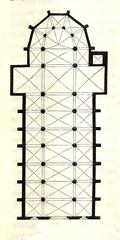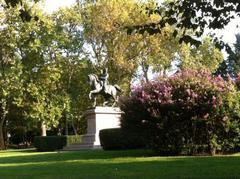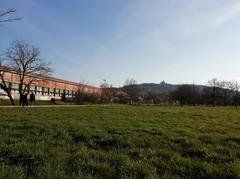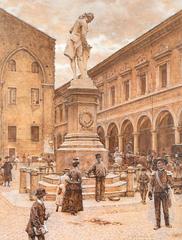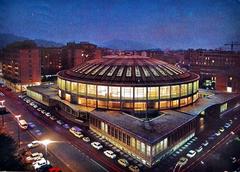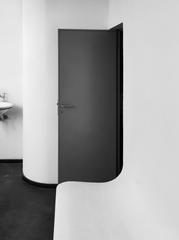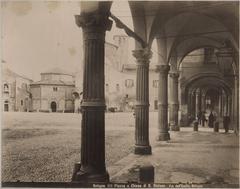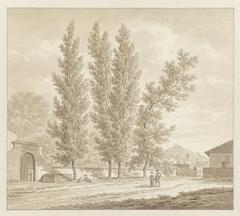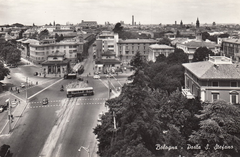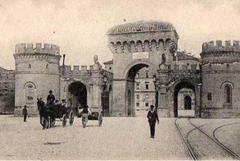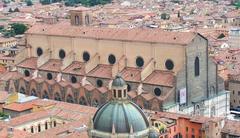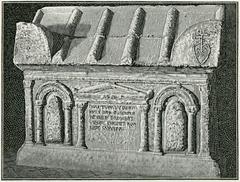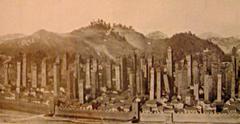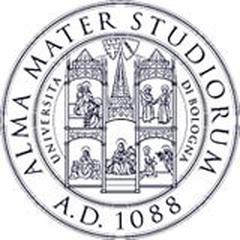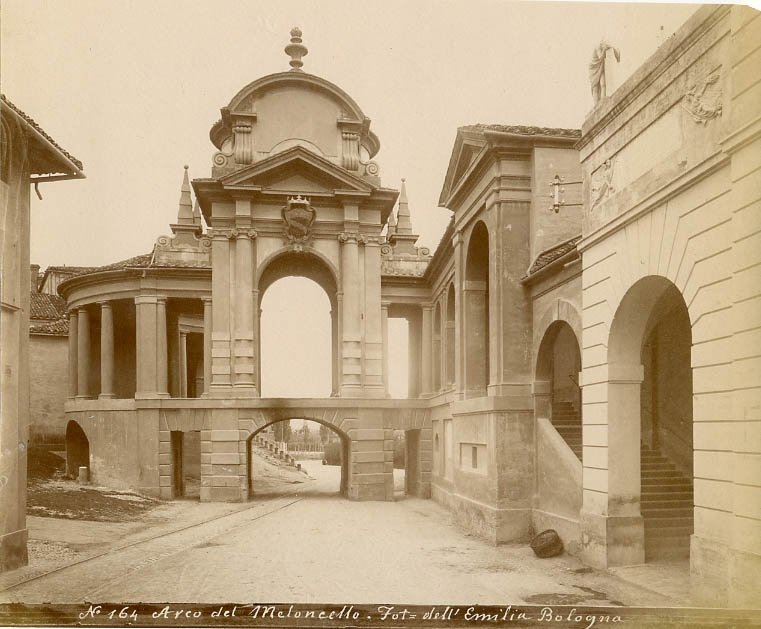
Arco Del Meloncello: Visiting Hours, Tickets, and Historical Insights
Date: 16/08/2024
Introduction
Discover the Arco del Meloncello, a stunning Rococo arch that stands as a testament to Bologna’s rich architectural and cultural history. Designed by Carlo Francesco Dotti in the early 18th century, this masterpiece was created to address a practical urban challenge while enhancing the aesthetic appeal of the city. The arch is an integral part of the Portico di San Luca, the world’s longest portico, which spans approximately 3.8 kilometers and features 666 arches (Wikipedia). This portico was constructed to protect the sacred icon of the Virgin of San Luca during its annual pilgrimage from the Sanctuary of the Madonna di San Luca to Bologna (The Travel Folk). In 2021, the porticoes of Bologna, including the Portico di San Luca and the Arco del Meloncello, were designated as a UNESCO World Heritage Site, highlighting their architectural and historical importance (The Travel Folk). This guide will provide you with comprehensive information on the history, cultural significance, visitor details, and travel tips to make the most of your visit to this iconic landmark.
Table of Contents
- Arco del Meloncello: A Guide to Bologna’s Historical Gem
Arco del Meloncello: A Guide to Bologna’s Historical Gem
Introduction
Discover the Arco del Meloncello, a stunning Rococo arch in Bologna, Italy. This guide will cover its rich history, cultural significance, visitor information, and tips to enhance your visit.
Historical Background
Architectural Genesis and Purpose
The Arco del Meloncello, a striking Rococo structure, was conceived in the early 18th century to address a practical urban challenge. The intersection of two roads at a right angle necessitated a solution that would allow uninterrupted pedestrian traffic, particularly for pilgrims journeying along the Portico di San Luca. The arch, designed by the architect Carlo Francesco Dotti, was the winning entry in a competition held in 1714. Dotti, with the assistance of Francesco Galli Bibiena, executed the project between 1721 and 1732 (Wikipedia).
Integration with the Portico di San Luca
The Arco del Meloncello is an integral part of the Portico di San Luca, the longest portico in the world, spanning approximately 3.8 kilometers with 666 arches. This portico was constructed between 1674 and 1793 to protect the sacred icon of the Virgin of San Luca during its annual pilgrimage from the Sanctuary of the Madonna di San Luca to Bologna (The Travel Folk). The arch itself marks a significant point along this route, serving as the final gate before the ascent to the sanctuary begins.
Structural Modifications
In the early 20th century, the Arco del Meloncello underwent significant modifications to accommodate modern transportation needs. Under the direction of Tito Azzolini, the arch was elevated by several meters to allow for the passage of a train beneath it (Wikipedia). This adaptation highlights the structure’s enduring relevance and the city’s commitment to preserving its historical architecture while integrating contemporary infrastructure.
Cultural and Religious Significance
The Portico di San Luca, and by extension the Arco del Meloncello, holds profound cultural and religious significance for the city of Bologna. The annual procession, which commemorates a miraculous event in 1433 when the city was spared from a devastatingly wet spring, continues to be a vital tradition. During this event, the sacred icon is carried from the sanctuary to the Cathedral of San Pietro in Bologna, where it remains for a week before being returned in another procession (The Travel Folk).
UNESCO World Heritage Status
In 2021, the porticoes of Bologna, including the Portico di San Luca and the Arco del Meloncello, were designated as a UNESCO World Heritage Site. This recognition underscores the architectural and historical importance of these structures, which collectively span 62 kilometers and date back to the 12th century (The Travel Folk).
Architectural Details and Aesthetic
The Arco del Meloncello is a quintessential example of Rococo architecture, characterized by its ornate and theatrical design. The arch’s aesthetic appeal lies in its intricate details and the harmonious integration with the surrounding portico. The structure not only serves a functional purpose but also enhances the visual experience of the pilgrimage route, offering a picturesque transition from the urban landscape to the serene ascent towards the sanctuary.
Visitor Information
Visiting Hours and Tickets
The Arco del Meloncello is accessible 24/7, and there is no admission fee. However, consider visiting during daylight hours to fully appreciate its architectural beauty.
Accessibility
The arch is part of the Portico di San Luca, which is wheelchair accessible. The path is suitable for visitors of all ages and fitness levels.
Nearby Attractions
While in Bologna, explore nearby historical sites such as the Sanctuary of the Madonna di San Luca and the city’s renowned porticoes, now a UNESCO World Heritage Site.
Preservation and Modern Use
Despite its historical origins, the Arco del Meloncello remains a functional part of Bologna’s urban fabric. The arch continues to facilitate pedestrian movement along the Portico di San Luca, while also accommodating modern transportation needs. This dual functionality is a testament to the city’s ability to preserve its historical heritage while adapting to contemporary requirements.
Visitor Experience
For visitors, the Arco del Meloncello offers a unique glimpse into Bologna’s rich architectural and cultural history. The arch serves as a starting point for the uphill climb to the Sanctuary of the Madonna di San Luca, a journey that combines physical exertion with spiritual reflection. Along the way, travelers can appreciate the numerous shrines and chapels that line the route, each with its own historical and artistic significance (The Travel Folk).
FAQ
What are the visiting hours for Arco del Meloncello?
The Arco del Meloncello is accessible 24/7.
How do I get to Arco del Meloncello?
The Arco del Meloncello is located along the Portico di San Luca in Bologna. It is easily reachable by foot or public transportation.
Are there guided tours available?
While there are no specific guided tours for the Arco del Meloncello, many tours of Bologna include the Portico di San Luca and the arch as part of their itinerary.
Conclusion
The Arco del Meloncello stands as a remarkable example of Bologna’s architectural ingenuity and cultural heritage. Whether you’re part of a pilgrimage or taking a leisurely stroll, this landmark offers a profound connection to Bologna’s past and present. Download our mobile app Audiala for more travel tips and follow us on social media for the latest updates.
Conclusion
The Arco del Meloncello is not just an architectural marvel but a symbol of Bologna’s rich cultural and historical tapestry. Its Rococo design, historical significance, and integration with the Portico di San Luca make it a must-visit for anyone exploring Bologna. Whether you’re part of the annual pilgrimage or simply taking a leisurely stroll, the arch offers a profound connection to the city’s past and present. With its 24/7 accessibility and no admission fee, it is an easily accessible attraction that provides a unique and enriching experience. From its construction to accommodate modern transportation needs to its role in religious and cultural traditions, the Arco del Meloncello continues to be a vital part of Bologna’s urban fabric. For those planning a visit, this guide offers all the necessary information and tips to ensure a memorable experience. As you explore this historical gem, you’ll gain a deeper appreciation for Bologna’s architectural ingenuity and cultural heritage (Facaros & Pauls, May Cause Wanderlust, Italian Traditions).
References
- Wikipedia (n.d.). Arco del Meloncello. Retrieved from Wikipedia
- The Travel Folk (n.d.). Portico di San Luca, Bologna. Retrieved from The Travel Folk
- Facaros & Pauls (n.d.). Arco del Meloncello. Retrieved from Facaros & Pauls
- May Cause Wanderlust (n.d.). Portico di San Luca. Retrieved from May Cause Wanderlust
- Italian Traditions (n.d.). Arcades of Bologna: History of Iconic. Retrieved from Italian Traditions

